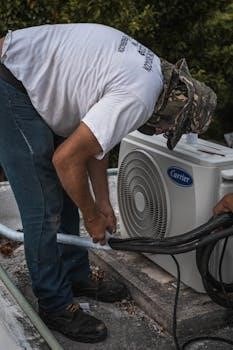Carrier Infinity Thermostat Troubleshooting⁚ A Comprehensive Guide

This comprehensive guide provides solutions for common Carrier Infinity thermostat issues․ Learn to troubleshoot problems like blank screens, error codes, communication failures, and zoning faults․ Discover steps for resolving wiring issues, connectivity problems, and temperature inaccuracies․

Initial Checks and Basic Troubleshooting
Before diving into complex troubleshooting, perform these initial checks․ First, ensure your Carrier Infinity thermostat has power․ If the screen is blank, check for dead batteries or issues with the C-wire connection․ Verify that the thermostat is securely mounted and that all wiring connections are tight․ Examine the display for any visible error codes, as these can provide clues about the problem․ If your thermostat is battery powered, try replacing them with fresh ones․ If it is powered by the C-wire, make sure that the power supply to the HVAC system is turned on․ Another basic step is to clean the thermostat․ Dust and debris can interfere with sensors or electrical connections․ Use a soft cloth or canned air to gently clean it․ Next, check that the thermostat is correctly programmed for your desired temperature settings․ Make sure there are no conflicting schedules or incorrect settings that may cause your issue․ Sometimes, a simple power cycle of the thermostat is enough to solve the problem․ Finally, ensure that the system settings are correctly configured for your heating or cooling needs․
Power Issues and Blank Screen Problems
A blank screen on your Carrier Infinity thermostat often indicates a power issue․ First, verify if your thermostat uses batteries․ If so, replace them with new ones, ensuring they are installed correctly․ If your thermostat relies on a C-wire for power, check the circuit breaker for your HVAC system and make sure it’s not tripped․ Examine the C-wire connection at both the thermostat and the HVAC system to ensure it’s secure and not damaged․ If you have a multimeter, test the voltage at the thermostat’s terminals to confirm power is reaching the device․ Look for any signs of corrosion, damage, or loose connections at the wiring terminals․ Sometimes, power surges or electrical issues can cause temporary problems․ Try turning off the power to your HVAC system and then turning it back on after a few minutes․ If the problem persists, there may be an issue with the transformer or control board of your HVAC system․ If you have made all these checks and the screen is still blank, it’s best to seek professional help․
Understanding and Resolving Error Codes
Carrier Infinity thermostats display error codes to pinpoint specific problems․ These codes can range from simple issues to more complex system failures․ Consult your thermostat’s user manual for a list of error codes and their meanings․ Some common codes might relate to communication issues between the thermostat and the HVAC system, problems with the indoor or outdoor unit, or sensor malfunctions․ When you encounter an error code, note it down for reference․ Try restarting your thermostat by turning off the power and turning it back on․ If the code reappears, check the specific components associated with that error․ For example, if the code indicates a communication problem, inspect the wiring for loose connections․ If the code points to a faulty sensor, you may need to replace the sensor․ Sometimes error codes are triggered by temporary glitches, but if the code remains after troubleshooting, you should call a qualified HVAC technician․ They possess the tools and expertise to diagnose and resolve complex issues accurately․ Avoid making drastic changes without understanding the underlying problem․
Wiring Issues⁚ ABCD Connections and Legacy Systems
Carrier Infinity systems utilize ABCD wiring for communication between components, and proper connections are crucial for correct operation․ Ensure that the ABCD wires are securely connected to the corresponding terminals on both the thermostat and the control board․ Verify that the color of each wire matches at both ends․ Incorrect wiring can lead to communication errors or system malfunctions․ Legacy systems, which might have older wiring configurations, require a different approach․ In some cases, legacy wiring may not support all the features of the Infinity system․ If you encounter issues with a legacy setup, consult the owner’s manual for specific wiring diagrams and configurations․ When dealing with legacy systems, you might have to use R, W for heat, G for the fan, Y, and C for the AC condenser, and C as a common wire․ If you are unsure about the wiring of your system, it is best to consult a certified HVAC technician to avoid damage to the equipment or incorrect installation․ Document all connections before making changes․
Thermostat Not Communicating with the System
When a Carrier Infinity thermostat fails to communicate with the system, several factors can be the cause․ First, check the ABCD wiring connections for any loose or incorrect placements․ Ensure the wires are securely attached to the corresponding terminals on both the thermostat and the system’s control board․ Another potential issue is a faulty communication wire․ Check for any breaks, kinks, or damage along the wire’s length․ If the wiring appears intact, it may be a power issue․ Verify that the indoor unit has power and that the amber LED is lit on the control circuit board․ If the system still isn’t responding, perform a system reset․ Consult the owner’s manual for specific reset instructions․ If these steps do not restore communication, the issue might be with the control board itself or the thermostat․ You may require the expertise of a professional technician to diagnose and repair the problem․ It is important to note all steps taken before contacting a professional․
Zoning System Faults and Failures
Carrier Infinity zoning systems can experience faults and failures due to various reasons․ A common issue arises from a failing damper, which can prevent proper airflow to specific zones․ This may be indicated by a zoning static pressure test failure․ Verify that all dampers are opening and closing as intended․ Another potential issue is incorrect wiring to the ABCD connections on all devices within the zoning system․ Ensure all colors match for every terminal, and that the wires are securely connected․ If the zoning system is not powering up, recheck the wiring and confirm that power is applied to the indoor unit․ Look for the amber LED on the indoor control circuit board to verify power․ Occasionally, dust accumulation can interfere with the system’s operation, so carefully clean the inside of the zoning system components with a soft cloth or canned air․ If these steps do not resolve the issue, it’s essential to seek the assistance of a qualified HVAC technician, particularly one with expertise in zoning system troubleshooting․
Heat Pump Troubleshooting
Troubleshooting a Carrier heat pump that isn’t working correctly can be challenging․ A frequent complaint is the heat pump blowing cold air instead of warm air․ Start by checking the thermostat settings to ensure it is set to heat mode and that the desired temperature is higher than the current room temperature․ Verify the air filter is clean, as a clogged filter can restrict airflow․ If your system has an outdoor unit, check for any obstructions around it, such as ice or debris․ If the problem persists, it could be a refrigerant issue or a malfunctioning reversing valve, which often requires professional attention․ Also, ensure that the defrost cycle is working correctly, as frost buildup on the outdoor unit can reduce heating efficiency․ It’s crucial to address heat pump issues promptly to prevent further damage and ensure optimal performance․ If you are not confident in your troubleshooting abilities, consult a certified HVAC technician for expert advice and repairs․

Furnace Troubleshooting Guide
If your Carrier furnace isn’t heating, start by verifying the thermostat is correctly set to heat and the desired temperature is higher than the room temperature․ Check the furnace’s power switch and circuit breaker to ensure they are on․ A common issue is a dirty air filter, which can restrict airflow and cause the furnace to overheat or shut down․ Inspect the pilot light or igniter, ensuring it’s functioning correctly․ If you have a gas furnace, confirm the gas supply is on․ If the pilot light is on but the main burner won’t light, check the flame sensor․ A faulty flame sensor can prevent the furnace from igniting․ Also, examine the vent system for any blockages that could cause problems․ If the furnace still fails to operate, there might be issues with the control board, blower motor, or other internal components, which often require professional repair․ Always prioritize safety and call a qualified HVAC technician if you are unsure or uncomfortable with troubleshooting furnace issues․

Connectivity Problems⁚ Wi-Fi and Internet
Experiencing Wi-Fi or internet connectivity issues with your Carrier Infinity thermostat can disrupt its remote control and monitoring capabilities․ First, verify that your home Wi-Fi network is functioning correctly and that other devices can connect․ Ensure that the thermostat is within the router’s range and that there are no obstructions blocking the signal․ Check the thermostat’s Wi-Fi settings to confirm it’s connected to the correct network and that the password is accurate․ Sometimes, simply restarting your router can resolve temporary connection problems․ If the thermostat is still not connecting, try power cycling it by turning it off and on again․ Some Carrier models may have a reset procedure; consult your owner’s manual for specific instructions․ Consider using the RouteThis app, which is designed to troubleshoot Wi-Fi connectivity issues with Carrier thermostats․ If these steps fail, compatibility issues with your router may be the cause, or the thermostat may need a firmware update, which might require professional assistance․
Temperature Inaccuracy Issues
If your Carrier Infinity thermostat is displaying inaccurate temperature readings, several factors could be the cause․ First, ensure the thermostat is not located in a spot that is exposed to direct sunlight, drafts, or heat sources, as these can affect its readings․ Confirm the thermostat is securely mounted on the wall and not loose․ A build-up of dust or debris inside the thermostat can also interfere with its sensors; gently clean it with a soft cloth or canned air․ Check if the thermostat is in its “deadband,” where the system remains idle until the temperature drifts outside the set range․ If the thermostat’s calibration is off, you may need to adjust the temperature offset in the settings menu, if your model supports it․ Another possible cause is a faulty sensor, which might require professional replacement․ Lastly, consider if the issue is with the entire system rather than just the thermostat; for example, a malfunctioning furnace could cause the thermostat to report inaccurate data․
Using the Carrier Infinity Checkout Mode
The Carrier Infinity thermostat features a valuable tool known as “Checkout Mode,” designed to assist in diagnosing system issues․ This mode performs a comprehensive check of your entire Infinity system, identifying any malfunctions that may require attention․ To access Checkout Mode, navigate to the appropriate menu option within your thermostat’s interface․ Once activated, the system will run through a series of tests, evaluating the performance of various components, such as the furnace, air conditioner, and zone dampers․ The process usually takes several minutes, and the results will be displayed on the thermostat screen․ If any faults are detected, the system will often provide error codes or messages that can be used for further troubleshooting․ This feature is particularly helpful for pinpointing problems with the Infinity system, simplifying the repair process․ It’s a great way to proactively assess the health of your HVAC system and prevent small issues from escalating into larger problems․ Refer to your owner’s manual for exact steps for your model․
Advanced Troubleshooting and Professional Help
When basic troubleshooting steps fail to resolve your Carrier Infinity thermostat issues, it may be time to consider advanced troubleshooting or professional assistance․ Complex problems, such as intermittent communication errors, intricate zoning failures, or deeply embedded software glitches, often require specialized knowledge and diagnostic equipment․ If you are uncomfortable working with electrical components or lack the necessary expertise, it is best to consult a certified HVAC technician․ These professionals are trained to handle complex HVAC systems and can accurately diagnose the underlying problems․ They can also perform repairs that require specialized tools and expertise․ In cases where the issue involves a malfunctioning component within the furnace or air conditioning unit, professional intervention may be necessary․ Additionally, issues related to the system’s software or network configuration may require an expert’s touch․ Don’t hesitate to seek help if you are unsure how to proceed; a qualified technician can quickly restore your system to its optimal performance․ Remember, attempting advanced repairs without proper knowledge could potentially lead to further damage․
Preventative Maintenance Tips
Regular preventative maintenance is crucial for the longevity and reliable performance of your Carrier Infinity thermostat and overall HVAC system․ Start by periodically checking the thermostat’s display for any error codes and address them promptly․ Clean the thermostat’s exterior with a soft, dry cloth to prevent dust accumulation, which can affect performance․ If your model uses batteries, replace them annually or as recommended by the manufacturer to avoid unexpected power loss․ Ensure that all wiring connections are secure and free from corrosion; loose or corroded connections can cause communication problems․ Keep the area around the thermostat clear of obstructions to allow for accurate temperature readings․ Consider scheduling annual professional HVAC maintenance; a technician can inspect the entire system, including the thermostat, and identify potential issues before they escalate․ They can also clean the components, check refrigerant levels, and ensure that your system is operating at peak efficiency․ Regular maintenance minimizes the risk of breakdowns and helps extend the lifespan of your equipment, saving you money in the long run․